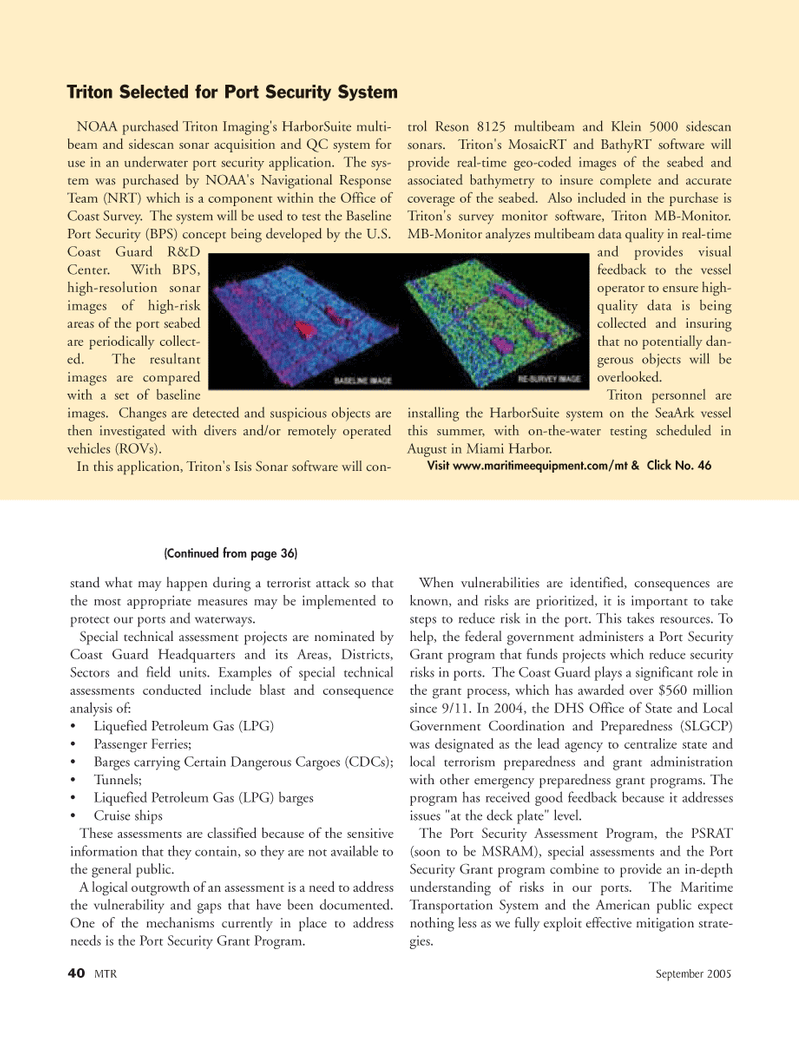
Page 40: of Marine Technology Magazine (September 2005)
Maritime Security & Undersea Defense
Read this page in Pdf, Flash or Html5 edition of September 2005 Marine Technology Magazine
NOAA purchased Triton Imaging's HarborSuite multi- beam and sidescan sonar acquisition and QC system for use in an underwater port security application. The sys- tem was purchased by NOAA's Navigational Response
Team (NRT) which is a component within the Office of
Coast Survey. The system will be used to test the Baseline
Port Security (BPS) concept being developed by the U.S.
Coast Guard R&D
Center. With BPS, high-resolution sonar images of high-risk areas of the port seabed are periodically collect- ed. The resultant images are compared with a set of baseline images. Changes are detected and suspicious objects are then investigated with divers and/or remotely operated vehicles (ROVs).
In this application, Triton's Isis Sonar software will con- trol Reson 8125 multibeam and Klein 5000 sidescan sonars. Triton's MosaicRT and BathyRT software will provide real-time geo-coded images of the seabed and associated bathymetry to insure complete and accurate coverage of the seabed. Also included in the purchase is
Triton's survey monitor software, Triton MB-Monitor.
MB-Monitor analyzes multibeam data quality in real-time and provides visual feedback to the vessel operator to ensure high- quality data is being collected and insuring that no potentially dan- gerous objects will be overlooked.
Triton personnel are installing the HarborSuite system on the SeaArk vessel this summer, with on-the-water testing scheduled in
August in Miami Harbor.
Visit www.maritimeequipment.com/mt & Click No. 46 40 MTR September 2005
Triton Selected for Port Security System stand what may happen during a terrorist attack so that the most appropriate measures may be implemented to protect our ports and waterways.
Special technical assessment projects are nominated by
Coast Guard Headquarters and its Areas, Districts,
Sectors and field units. Examples of special technical assessments conducted include blast and consequence analysis of: • Liquefied Petroleum Gas (LPG) Passenger Ferries; Barges carrying Certain Dangerous Cargoes (CDCs); Tunnels; Liquefied Petroleum Gas (LPG) barges Cruise ships
These assessments are classified because of the sensitive information that they contain, so they are not available to the general public.
A logical outgrowth of an assessment is a need to address the vulnerability and gaps that have been documented.
One of the mechanisms currently in place to address needs is the Port Security Grant Program.
When vulnerabilities are identified, consequences are known, and risks are prioritized, it is important to take steps to reduce risk in the port. This takes resources. To help, the federal government administers a Port Security
Grant program that funds projects which reduce security risks in ports. The Coast Guard plays a significant role in the grant process, which has awarded over $560 million since 9/11. In 2004, the DHS Office of State and Local
Government Coordination and Preparedness (SLGCP) was designated as the lead agency to centralize state and local terrorism preparedness and grant administration with other emergency preparedness grant programs. The program has received good feedback because it addresses issues "at the deck plate" level.
The Port Security Assessment Program, the PSRAT (soon to be MSRAM), special assessments and the Port
Security Grant program combine to provide an in-depth understanding of risks in our ports. The Maritime
Transportation System and the American public expect nothing less as we fully exploit effective mitigation strate- gies. (Continued from page 36)
MTR#2 (33-48).qxd 8/30/2005 5:28 PM Page 40

 39
39

 41
41
